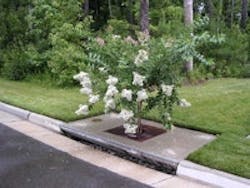Filterra Stormwater System Approved by Washington State Department of Ecology
The Washington State Department of Ecology (DOE) has issued a Conditional Use Level Designation for basic (TSS) and phosphorus treatment for Americast’s Filterra Stormwater Bioretention Filtration System.
Based on submissions from Americast, the Washington DOE Technical Review Committee determined bioretention filtration met their standards for basic treatment. The state’s DOE issued Filterra two designations for bioretention filtration use: a conditional short-term use for basic and phosphorus treatment and a pilot use for enhanced and oil treatment. The Washington DOE’s conditions of use say the Filterra units meet conditions identified by the Western Washington Hydrology Model or other state DOE approved continuous runoff models.
The designation of natural, biological filtration technology in Washington demonstrates a significant change in approved methods for basic treatment compared to other methods, such as media filtration. Bioretention filtration is an engineered process for managing storm water runoff, using the chemical, biological and physical properties of the natural interaction of plants, microbes and soil. It improves water quality by removing pollutants and nutrients associated with urban runoff. Although it is a newer approach for storm water filtration, the principle of biological treatment using “rain gardens” and natural filtration is well established in many parts of the country and forms the basis for agricultural and wastewater treatment practices.
Based on 15 years of research and development in bioretention testing and field monitoring, Filterra has gained approval of this technology for storm water management projects in Washington and throughout the northwest. The Filterra system has no moving parts or special components to replace. Unlike end-of-line treatment systems, it treats smaller drainage areas closer to the source of pollutants. Easy to design and install, the Filterra system requires little long-term maintenance and can be strategically fit into existing landscape designs, making it an attractive solution for new construction, as well as site retrofits.
Source: Americast


